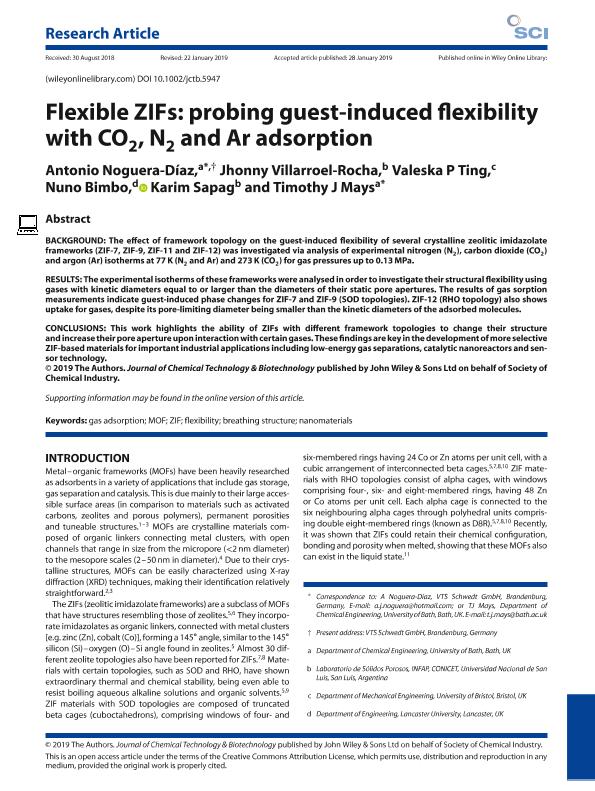Artículo
Flexible ZIFs: Probing guest‐induced flexibility with CO2, N2 and Ar adsorption
Noguera Díaz, Antonio; Villarroel Rocha, Jhonny ; Ting, Valeska P.; Bimbo, Nuno; Sapag, Manuel Karim
; Ting, Valeska P.; Bimbo, Nuno; Sapag, Manuel Karim ; Mays, Timothy J.
; Mays, Timothy J.
 ; Ting, Valeska P.; Bimbo, Nuno; Sapag, Manuel Karim
; Ting, Valeska P.; Bimbo, Nuno; Sapag, Manuel Karim ; Mays, Timothy J.
; Mays, Timothy J.
Fecha de publicación:
11/2019
Editorial:
John Wiley & Sons Ltd
Revista:
Journal of Chemical Technology and Biotechnology
ISSN:
0268-2575
e-ISSN:
1097-4660
Idioma:
Inglés
Tipo de recurso:
Artículo publicado
Clasificación temática:
Resumen
BACKGROUND: The effect of framework topology on the guest-induced flexibility of several crystalline zeolitic imidazolateframeworks (ZIF-7, ZIF-9, ZIF-11 and ZIF-12) was investigated via analysis of experimental nitrogen (N2), carbon dioxide (CO2)and argon (Ar) isotherms at 77 K (N2 and Ar) and 273 K (CO2) for gas pressures up to 0.13MPa. RESULTS: The experimental isotherms of these frameworkswere analysed in order to investigate their structural flexibility usinggases with kinetic diameters equal to or larger than the diameters of their static pore apertures. The results of gas sorptionmeasurements indicate guest-induced phase changes for ZIF-7 and ZIF-9 (SOD topologies). ZIF-12 (RHO topology) also showsuptake for gases, despite its pore-limiting diameter being smaller than the kinetic diameters of the adsorbed molecules. CONCLUSIONS: This work highlights the ability of ZIFs with different framework topologies to change their structureandincrease their pore apertureuponinteraction with certain gases.These findings are key in thedevelopment ofmore selectiveZIF-basedmaterials for important industrial applications including low-energy gas separations, catalytic nanoreactors and sensortechnology.
Palabras clave:
GAS ADSORPTION
,
MOF
,
ZIF
,
FLEXIBILITY
,
BREATHING STRUCTURE
,
NANOMATERIALS
Archivos asociados
Licencia
Identificadores
Colecciones
Articulos(INFAP)
Articulos de INST. DE FISICA APLICADA "DR. JORGE ANDRES ZGRABLICH"
Articulos de INST. DE FISICA APLICADA "DR. JORGE ANDRES ZGRABLICH"
Citación
Noguera Díaz, Antonio; Villarroel Rocha, Jhonny; Ting, Valeska P.; Bimbo, Nuno; Sapag, Manuel Karim; et al.; Flexible ZIFs: Probing guest‐induced flexibility with CO2, N2 and Ar adsorption; John Wiley & Sons Ltd; Journal of Chemical Technology and Biotechnology; 94; 12; 11-2019; 3787-3792
Compartir
Altmétricas



